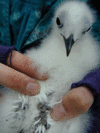Parasites of seabirds: A survey of effects and ecological implications
- PMID: 31229148
- PMCID: PMC7172769
- DOI: 10.1016/bs.amb.2019.02.001
Parasites of seabirds: A survey of effects and ecological implications
Abstract
Parasites are ubiquitous in the environment, and can cause negative effects in their host species. Importantly, seabirds can be long-lived and cross multiple continents within a single annual cycle, thus their exposure to parasites may be greater than other taxa. With changing climatic conditions expected to influence parasite distribution and abundance, understanding current level of infection, transmission pathways and population-level impacts are integral aspects for predicting ecosystem changes, and how climate change will affect seabird species. In particular, a range of micro- and macro-parasites can affect seabird species, including ticks, mites, helminths, viruses and bacteria in gulls, terns, skimmers, skuas, auks and selected phalaropes (Charadriiformes), tropicbirds (Phaethontiformes), penguins (Sphenisciformes), tubenoses (Procellariiformes), cormorants, frigatebirds, boobies, gannets (Suliformes), and pelicans (Pelecaniformes) and marine seaducks and loons (Anseriformes and Gaviiformes). We found that the seabird orders of Charadriiformes and Procellariiformes were most represented in the parasite-seabird literature. While negative effects were reported in seabirds associated with all the parasite groups, most effects have been studied in adults with less information known about how parasites may affect chicks and fledglings. We found studies most often reported on negative effects in seabird hosts during the breeding season, although this is also the time when most seabird research occurs. Many studies report that external factors such as condition of the host, pollution, and environmental conditions can influence the effects of parasites, thus cumulative effects likely play a large role in how parasites influence seabirds at both the individual and population level. With an increased understanding of parasite-host dynamics it is clear that major environmental changes, often those associated with human activities, can directly or indirectly affect the distribution, abundance, or virulence of parasites and pathogens.
Keywords: Bacteria; Bird; Ectoparasite; Endoparasite; Helminth; Marine; Parasitism; Pathogen; Seabird; Virus.
© 2019 Elsevier Ltd. All rights reserved.
Figures





Similar articles
-
Long: Influence of water masses on the summer structure of the seabird community in the northeastern Chukchi Sea.PLoS One. 2022 Apr 7;17(4):e0266182. doi: 10.1371/journal.pone.0266182. eCollection 2022. PLoS One. 2022. PMID: 35390036 Free PMC article.
-
The ecology of fish parasites with particular reference to helminth parasites and their salmonid fish hosts in Welsh rivers: a review of some of the central questions.Adv Parasitol. 2002;52:1-154. doi: 10.1016/s0065-308x(02)52011-x. Adv Parasitol. 2002. PMID: 12521260 Review.
-
Assessing the effects of climate on host-parasite interactions: a comparative study of European birds and their parasites.PLoS One. 2013 Dec 31;8(12):e82886. doi: 10.1371/journal.pone.0082886. eCollection 2013. PLoS One. 2013. PMID: 24391725 Free PMC article.
-
Impact of anthropogenous environmental factors on the marine ecosystem of trophically transmitted helminths and hosting seabirds: Focus on North Atlantic, North Sea, Baltic and the Arctic seas.Helminthologia. 2023 Dec 31;60(4):300-326. doi: 10.2478/helm-2023-0034. eCollection 2023 Dec. Helminthologia. 2023. PMID: 38222492 Free PMC article. Review.
-
Comparative tests of ectoparasite species richness in seabirds.BMC Evol Biol. 2007 Nov 15;7:227. doi: 10.1186/1471-2148-7-227. BMC Evol Biol. 2007. PMID: 18005412 Free PMC article.
Cited by
-
Protein Deimination and Extracellular Vesicle Profiles in Antarctic Seabirds.Biology (Basel). 2020 Jan 8;9(1):15. doi: 10.3390/biology9010015. Biology (Basel). 2020. PMID: 31936359 Free PMC article.
-
Prevalence of Haemosporidian Parasites in an Arctic Breeding Seabird Species-The Red-Throated Diver (Gavia stellata).Microorganisms. 2022 Oct 29;10(11):2147. doi: 10.3390/microorganisms10112147. Microorganisms. 2022. PMID: 36363741 Free PMC article.
-
Poxviral Strategies to Overcome Host Cell Apoptosis.Pathogens. 2020 Dec 23;10(1):6. doi: 10.3390/pathogens10010006. Pathogens. 2020. PMID: 33374867 Free PMC article. Review.
-
Analysis of free-living seabirds from Brazil as potential hosts of Toxoplasma gondii and serological investigation for antibodies against Leptospira spp.Vet Res Commun. 2024 Nov 19;49(1):14. doi: 10.1007/s11259-024-10575-x. Vet Res Commun. 2024. PMID: 39560806
-
The First Genome of the Balearic Shearwater (Puffinus mauretanicus) Provides a Valuable Resource for Conservation Genomics and Sheds Light on Adaptation to a Pelagic lifestyle.Genome Biol Evol. 2022 May 3;14(5):evac067. doi: 10.1093/gbe/evac067. Genome Biol Evol. 2022. PMID: 35524941 Free PMC article.
References
-
- Alonso A., Garrido J. Arthropods in shag (Phalacrocorax aristotelis) nests from the national park of the Atlantic Islands (NW Spain): occurrence and abundance at different breeding phases. Vie Milieu. 2009;59(1):59–68.
-
- Anderson D.J. Differential responses of boobies and other seabirds in the Galapagos to the 1986-87 El Nino-Southern oscillation event. Mar. Ecol. Prog. Ser. 1989;52(3):209–216. Oldendorf.
-
- Anderson D.J., Fortner S. Waved albatross egg neglect and associated mosquito ectoparasitism. Condor. 1988;90(3):727–729.
Further reading
-
- Abad F.X., Busquets N., Sanchez A., Ryan P.G., Majó N., Gonzalez-Solís J. Serological and virological surveys of the influenza A viruses in Antarctic and sub-Antarctic penguins. Antarct. Sci. 2013;25(2):339–344.
-
- Arnal A., Vittecoq M., Pearce-Duvet J., Gauthier-Clerc M., Boulinier T., Jourdain E. Laridae: a neglected reservoir that could play a major role in avian influenza virus epidemiological dynamics. Crit. Rev. Microbiol. 2015;41(4):508–519. - PubMed
-
- Barbosa A., Benzal J., Vidal V., D'Amico V., Coria N., Diaz J., Motas M., Palacios M.J., Cuervo J.J., Ortiz J., Chitimia L. Seabird ticks (Ixodes uriae) distribution along the Antarctic Peninsula. Polar Biol. 2011;34(10):1621–1624.
-
- Booth D.T., Clayton D.H., Block B.A. Experimental demonstration of the energetic cost of parasitism in free-ranging hosts. Proc. R. Soc. Lond. B Biol. Sci. 1993;253(1337):125–129.
-
- Brito-Echeverría J., López-López A., Yarza P., Antón J., Rosselló-Móra R. Occurrence of Halococcus spp. in the nostrils salt glands of the seabird Calonectris diomedea. Extremophiles. 2009;13(3):557–565. - PubMed
Publication types
MeSH terms
LinkOut - more resources
Full Text Sources

